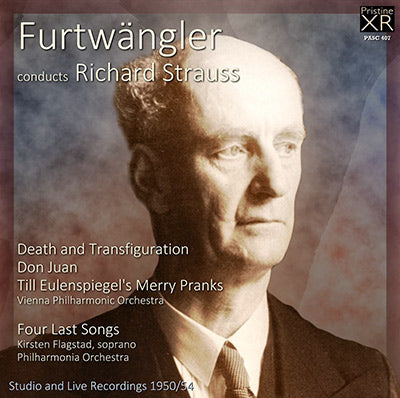
- Producer's Note
- Full Track Listing
- Cover Art
Wilhelm Furtwängler's brilliant interpretations of Richard Strauss
"Rarely can a first performance have served any music and its composer so well" - Fanfare
The decision to tackle Flagstad and Furtwängler's legendary première recording of Richard Strauss's Four Last Songs in the year of the composer's 150th birthday was taken following the suggestion of a correspondent who e-mailed me last summer with the idea. That it's taken more than nine months to bring to fruition has much to say for the difficulties involved in trying to do anything to improve the frankly abysmal quality of the original recording, originally captured on acetate discs that have seen far too many heavy needles over the years.
The flaws inherent in the original recordings are myriad: Surface noise is a constant intrusion; Thumps, bumps, clicks and scratches abound; The frequency range is limited, the frequency response deeply unrepresentative; Swish is endless to the point of being almost overwhelming; Distortion rears its head too often. Restoration and remastering technology can help enormously - XR remastering brings out much of the orchestral richness and texture and lifts a veil from Kirsten Flagstad's voice, whilst pitch correction helps with wayward wow and flutter. Much of the swish has been smoothed out, and noise reduction has done just that. The recording remains pretty compromised, as I suspect it always will, but once the ears have adjusted to the shortcomings of the medium there's much to be enjoyed and cherished.
The other three recordings were made in the Musikvereinssaal in Vienna for commercial releases. The first, Tod und Verklärung, was originally destined for 78rpm issue in 1950, and although it would have been taped, is of noticeably lower quality than the later, 1954 recordings. Hiss levels were higher and the upper frequencies less well defined - though of course all three recordings are much, much better from a technical point of view than the Four Last Songs. As with the Songs, the recordings all responded very well to XR remastering, which has once more brought new life and light to the orchestral sound.
-
R. STRAUSS Tod und Verklärung (Death and Transfiguration), Op. 24
Recorded 21, 23, 24 January 1950
Recording producer: Walter Legge
Recording Engineer: Anthony Griffith
First issued as HMV 78s DB.21169-71 -
R. STRAUSS Don Juan, Op. 20
Recorded 2 March,1954
-
R. STRAUSS Till Eulenspiegels lustige Streiche (Till Eulenspiegel's Merry Pranks), Op. 28
Recorded 3 March,1954Recording producer: Lawrance Collingwood
Vienna Philharmonic Orchestra
Recording Engineer: Francis Dillnutt
Recorded at the Musikvereinssaal, Vienna
First issued as HMV LP ALP.1208
Wilhelm Furtwängler, conductor
-
R. STRAUSS Vier letzte Lieder (Four Last Songs), Op. post.
Recorded 22 May, 1950
World Première, Royal Albert Hall, London
Kirsten Flagstad, soprano
Philharmonia Orchestra
Wilhelm Furtwängler, conductor
Fanfare Review
Anyone with a serious interest in Flagstad, Furtwängler, and/or Strauss’s Four Last Songs will find this a necessity
The world premiere of Strauss’s Four Last Songs
was given on May 22, 1950, at the Royal Albert Hall in London, and was
privately recorded. Versions of that recording (often misattributed as
the dress rehearsal) have circulated for many years on a variety of
labels, in sound ranging from the atrocious to the very poor. In 2008,
Testament came out with a version that sounded much better than its
predecessors, but was still difficult to enjoy. Now
So, then, the discussion can center on
the performance itself. Surely no singer since this premiere has sung
these songs with a richer, warmer, more full-sounding dramatic soprano
voice (though Jessye Norman brought similar qualities). Indeed, the
trend has been consistently toward lighter, more lyric sopranos. It is
important to remember that Strauss wrote these songs specifically with
Flagstad in mind, and persuaded her to learn them and sing the premiere
(though he died before it took place), and it was Flagstad who insisted
upon Furtwängler. In the decades since, we have become accustomed to
those lighter voices (Schwarzkopf imprinted herself on many of us), and
to a degree of specificity in word-pointing that Flagstad does not
deliver. One can find any number of performances with a greater variety
of inflection and vocal color, but very few with this degree of tonal
warmth and beauty throughout the range. Flagstad seems to be luxuriating
in this music, and she and Furtwängler are in synch with each other at
every turn of phrase. The orchestra positively glows at the beginning of
“Im Abendrot,” and that is more apparent in Pristine’s transfer than it
ever has been. The order of the songs at this premiere differs from
what has become the established order (remember that Strauss did not
necessarily conceive them as a set). Here we have “Beim Schlafengehen”;
“September”; “Frühling”; “Im Abendrot.” Even after
As is usual, there are very minimal
notes with the disc.
Henry Fogel
This article originally appeared in Issue 38:1 (Sept/Oct 2014) of Fanfare Magazine.

